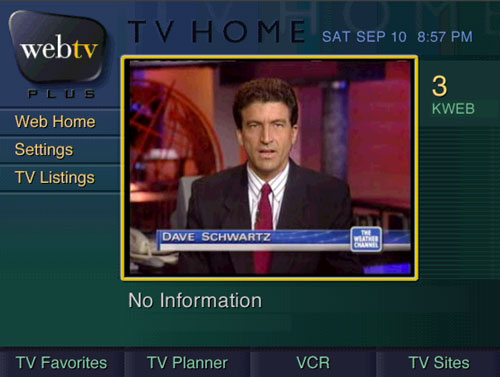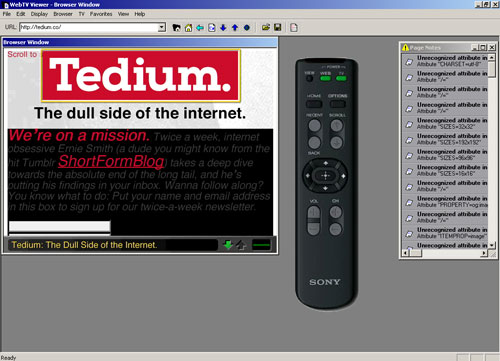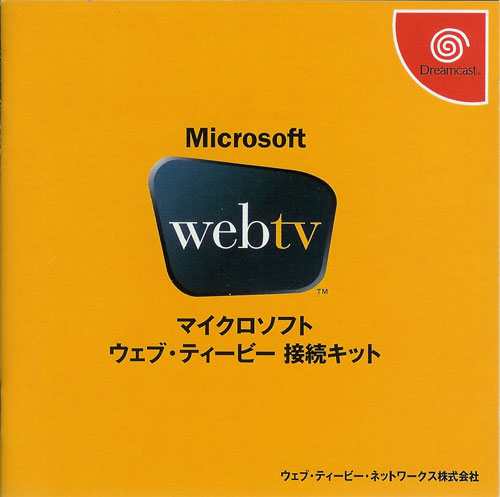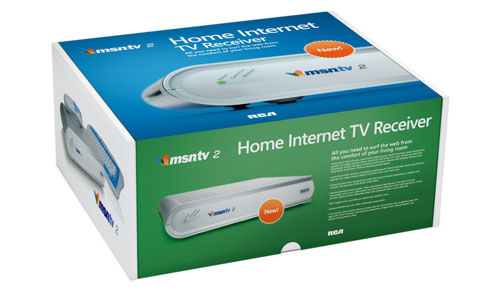The Internet Will Be Televised
Two decades ago, WebTV launched a bold idea into the mainstream … and caught the fringes. What can we learn about the internet from this noble failure?
"We won't tell you that TV will never be the same, because it will. It's you who will be different. Just watch."
— An introductory line spoken during a media roadshow-style event ahead of the launch of WebTV, on July 10, 1996. Roughly a year earlier, Steve Perlman and two other co-founders launched the company. During the presentation, Perlman, a onetime Apple employee who invented the firm's Quicktime technology that is still in heavy use today, called the WebTV reveal historic. "We've repackaged the internet to be designed for this type of medium," he said.

How hard was it to sell television-optimized internet to the public?
Despite being heavily hyped, WebTV struggled to gain traction during its early years.
The technology itself, first conceptualized by a startup of the same name and distributed by tech giants Sony and Philips, was impressive and forward-thinking at the time, taking advantage of a budding mainstream interest in the web as well as the fact that large swaths of the public (read: baby boomers and older) were not as adept with computers as their kids.
But the web was simply not designed for reading 10 feet away from the screen, despite changes made by Perlman and other developers that specifically focused on television readability. They made the text bigger, worked hard on the typography, and made it easy to scroll through links with a remote control. But it was still a slog.
Usability expert Jakob Nielsen, while impressed at the level of readability WebTV's developers got out of the device ("you have to see it to believe," Nielsen said of how clear the text showed up on a high-quality TV of the era), ultimately found the experience too limited for everyday use.
"WebTV achieves a very high level of usability given its design constraints," Nielsen wrote in 1997. "Unfortunately, the constraints are so severe that even this great design ultimately fails to provide an optimal Web user experience."
Perhaps one telling sign of the challenges of selling the public on WebTV comes from the roadshow clip. Cofounder Bruce Leak, as he showed off the capabilities of the system while searching for the television show Friends, had to stall a bit when the 1996-era website for NBC's Friends, a fairly primitive site by today's standards, struggled to load. The issue was two-fold: Modems are slow, but the page, additionally, was not optimized to work effectively on WebTV. There were a lot of pages like that at the time.

(Because I was curious, I tried out the WebTV developer tools to see how this horribly primitive system could handle Tedium's front page. As you can see above, the results are sexy.)
The solution to this issue, of course, is not unlike what we see happening today on mobile platforms: responsive websites, dedicated apps, and progressive approaches designed to take advantage of the small screen so that content is readable anywhere. But unlike mobile phones, where the user bases simply couldn't be ignored, WebTV for much of its history was the only company doing any of this stuff, and they didn't have enough subscribers to be taken seriously, so the idea of selling developers on creating a television-formatted version of their website was a nonstarter.
"It was a walled-garden dream of developing a WebTV version of the internet, just as AOL was doing at around the same time, and as Netscape attempted with its proprietary browser extensions," recalled Brad Hill, a marketer of the service at the time of its launch. "There was some uptake on the part of publishers, but most sites in the exponentially expanding web simply allowed WebTV to reformat their pages for better or worse. Sites were often ugly through the WebTV lens, and sometimes unusable."
But those obvious weaknesses didn't stop Microsoft from spending $425 million to purchase WebTV, less than eight months after its public launch. Maybe they saw something the public didn't.

Five interesting facts about WebTV
- Thomas Dolby, he of "She Blinded Me With Science" early-MTV fame, was involved in creating the notable blips for the WebTV through his company, Headspace. Dolby's company at the time was pushing forth an early music-streaming technology called RMF, meant to be complementary to MIDI and MP3 formats. WebTV was one of the few devices that supported it natively.
- For a brief period of time, WebTV's encryption was considered so tough that the U.S. government classified it as munitions, preventing the device from being released in Europe and other countries because it was considered a weapon of sorts. The laws eventually were changed, because (as anyone could figure out by using it) WebTV was not a weapon.
- WebTV, as it turned out, had at least one virus. In 2002, a man named David Jeansonne emailed WebTV users a malicious program that claimed to allow users to change the on-screen colors, but in reality actually changed the device's dial number to 911. Just 10 people were affected, but Jeansonne received prison time for the malicious action.
- Like the Prevue Channel, WebTV did have a community focused on hacking the device. Among the sneakier users of the platform was Matt Squadere, who has periodically been updating a site called HackTV since 1998. The site features info about secret areas on the platform and hacks to get games to work on a WebTV device. His actions actually got him banned from the service back in 1999.
- WebTV was not designed for video games, but at least one video game console supported WebTV. Owned by Microsoft at the time, the WebTV team helped get a Japanese version of the service on the Sega Dreamcast.
250k

Why Microsoft mostly left WebTV (also known as MSN TV) alone for 16 years
There was a period of time when WebTV could be considered something of a hit, if a modest one, and it was within the first year or two after Microsoft made its eye-popping purchase of the firm, which in comparison to Yahoo's $3.57 billion purchase of Geocities in 1999, wasn't too bad, considering.
But the thing is, the internet was moving too fast for a set-top device of this nature. While WebTV got an upgrade soon after its purchase from Microsoft that added some fairly interactive video features that predicted the launch of TiVo a few years later—as highlighted by this William Shatner-starring WebTV commercial from 1998—its web engine quickly found itself out of date, unable to keep up with the speedy changes of browsers like Netscape, Internet Explorer, and later, Firefox.
WebTV's proprietary setup was part of the problem, as it was designed from the ground up to offer a television-optimized experience. This meant that it couldn't easily take advantage of the open-source offerings of the era, and that porting Microsoft's comparably-better Internet Explorer would be a challenge. (It also didn't help that screen resolutions were quickly improving on computers, making the low resolution of TV sets even more of an issue.)
The Windows giant ultimately shifted the device's gears. They changed the name of the platform to MSN TV in 2001 and started giving away the devices to MSN members, convincing them to stay with the service (hey, they were desperate). Then, when it came time for an upgrade in 2004, the company released the MSN TV 2 with innards that were closer to the original Xbox than to the original WebTV. It had more robust media player features, along with an Intel Celeron processor. Moreso than the WebTV was, it was essentially a computer that worked on your TV.
Ron Goldin, a designer for Microsoft during the era, considered the interface design a major upgrade from the WebTV.
"The complete overhaul of the design for a then 4:3 resolution TV was ground-breaking in terms of its simplicity in navigating non-linear grids with no pointing device, as well as a custom keyboard for more involved tasks like composing emails," Goldin wrote on his website.
The new device utilized Internet Explorer, much closer to what people were actually using on their desktops, but the device still wasn't ideal for surfing the web—in part because TV screens by this point still hadn't caught up with their desktop competitors.
"The web browsing experience will depend on the sites that you visit," an UberGizmo review from 2006 stated. "Because MSN TV is using a somewhat low resolution, some websites won’t look the way they were intended to. Problems can go from scaled-down images to missing navigation."
In a lot of ways, the MSN TV 2, which was distributed by RCA, set the stage for all the devices we use on our TVs now. But it didn't get much in the way of upgrades after 2004—it was left to die on the vine.
But in 2013, more than 15 years after originally purchasing WebTV in 1997, and nine years after the release of the MSN TV 2, Microsoft said enough. That's when they finally killed the a set-top device intended to take over the world. It only took over a small part of it.
Don't shed any tears for WebTV. In a lot of ways, it's still with us.
(Also: Don't shed any tears for Steve Perlman. He's a serial entrepreneur who developed the also-defunct cloud-gaming service OnLive and an impressive-sounding cellular technology called pCell. He's also at the center of a legal battle around some face-scanning technology that has been used in some of your favorite big-budget action movies. The latter issue is a headache, but he's doing OK, even if WebTV didn't turn him into Steve Jobs 2.0.)
Ultimately, Microsoft found a better vessel for the WebTV idea in its Xbox console. While web browsing was not a prominent part of the Xbox or the Xbox 360 (though Internet Explorer was eventually installed on the 360), the Xbox One has stellar web-browsing capabilities that actually sort of make sense on a 60-inch screen.
Part of the reason for this is that a number of members of the Xbox team were alums of the WebTV service, and their fingerprints were all over the 360 in particular. (It helped that those WebTV alums were also involved in another noble experiment in interactive set-top boxes, the 3DO.)
But a bigger shift may be in the television itself. While fast internet streams are more common today; it's important to note that nearly every TV sold in stores these days relies on HD technology that's generally good enough to work as a computer monitor in a pinch. Sometimes, the screens are even better than HD.
But ultimately, people don't primarily use the Xbox One to surf the web and check their email, and they don't really use the Apple TV or Roku for those reasons, either. These devices are built for apps—big apps focused on games, small apps focused on video, but, no matter how you shake it, apps. And apps fully optimized for the interface, ultimately, were what the public really wanted from their TV-based online experiences.
The web is nice, but we prefer it within a foot or so of our faces.
:format(jpeg)/2017/06/tedium091316.gif)
/2017/06/tedium091316.gif)

/uploads/ernie_crop.jpg)